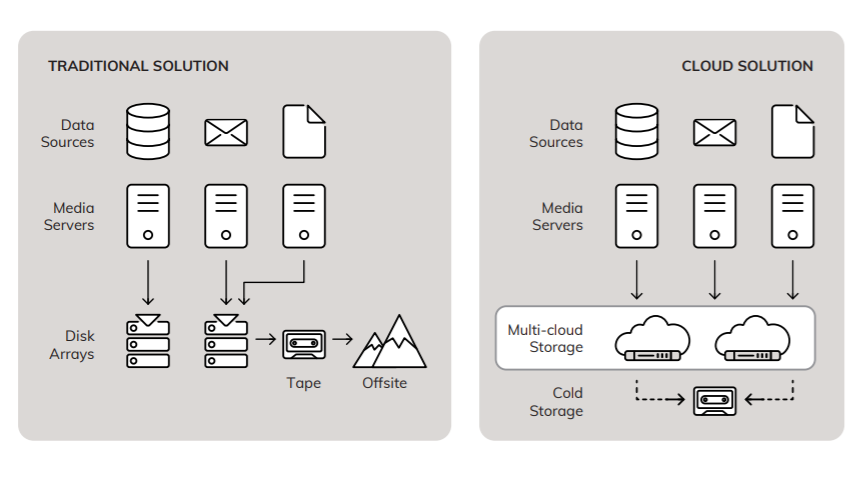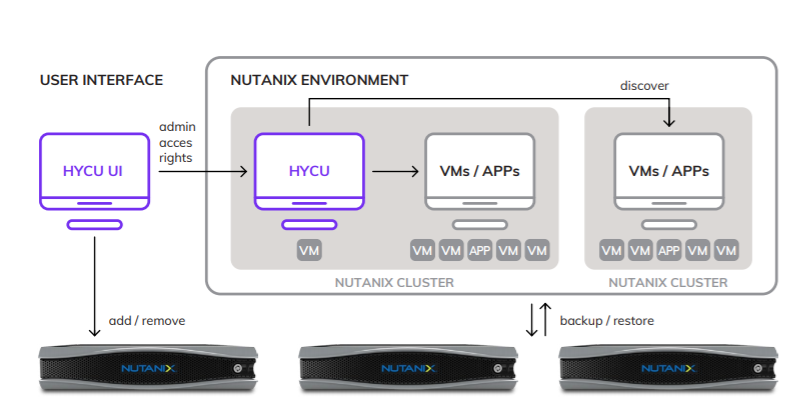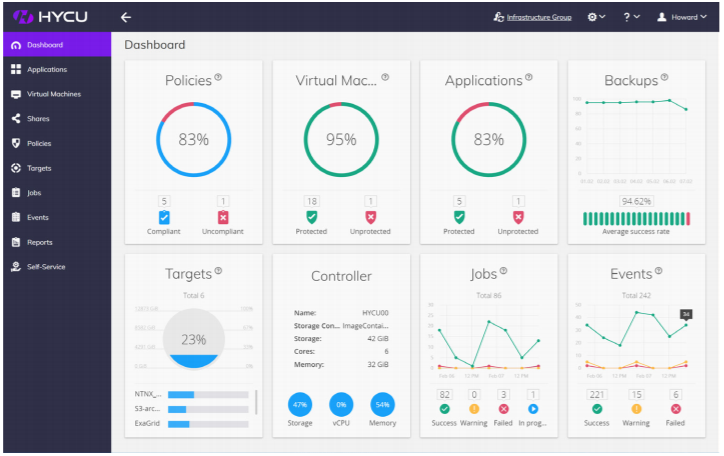Data Protection for Nutanix Cloud OS and Object Storage
Nutanix Enterprise Cloud OS and Today’s Data Growth
Handling explosive data growth is one of IT’s most significant challenges today and requires a way to store, access and protect it easily. Nutanix Enterprise Cloud OS extends services with a new object-based storage service called Acropolis Object Storage Service (OSS), part of the one-click deployment process, that will really help take things one step further.
OSS is a software-defined object storage solution that non-disruptively scales-out while lowering overall costs.
It’s designed with an S3-compatible REST API interface to handle terabytes to petabytes of unstructured data. OSS natively includes erasure coding, compression, and deduplication to optimize capacity utilization. Deployed and managed as part of the Nutanix Enterprise Cloud OS, it reduces the need for additional storage silos.
Why You Need Object Storage (and how to manage it)
The fact that data is growing is no surprise to anyone. And, the amount that data will continue to grow over time is in the zettabytes – and as we know, if each Gigabyte in a Zettabyte were a brick, 258 Great Walls of China (made of 3,873,000,000 bricks) could be built. According to a recent blog post by Rohit Goyal, Senior Product Marketing Manager at Nutanix, an industry perspective shared by international analyst firm IDC predicts by 2020 total volumes will hit 40 Zettabytes with about 63% of it being unstructured data.
As object storage is highly scalable and resilient, it is designed for the world of cloud computing, and data at scale with high growth rates. It is also ideally suited for unstructured data, with varying formats and file sizes, and allows data to be stored as objects instead of traditional blocks. This kind of storage is accessible over the network via simple S3-compatible HTTP REST APIs. S3 (Simple Storage Service) was developed by Amazon Web Services, which has become the standard for many object storage providers.
There are eight characteristics of object storage that make it ideally suited for explosive data growth but also the emergence of HCI platforms:
- Data is stored as objects, not traditional blocks
- Objects can include backups, archives, videos, images, logs, HTML files, and more.
- It’s unstructured because there is no mandatory format to the way data is stored.
- Unlike the directory structure found in traditional file systems, it utilizes a flat list of objects stored in “buckets.”
- Objects are stored using unique IDs rather than filenames, which drastically reduces the overhead required to store data.
- Objects are stored with user-defined metadata, making it easier to find objects at scale.
- Objects can be terabytes or even a few kilobytes in size, and a single bucket can hold billions of objects.
- Application developers can easily access objects using simple S3-compatible API calls through “GET” and “PUT” requests, without complex directory structures.
How Object Storage Helps You Fully Leverage the Nutanix Cloud Environment
With an object-based cloud storage environment, you now have a scalable solution to house all the business data coming at you, in every format and size. Yet, how can you ensure all your data is protected in the event of an unexpected outage or even during routine backup? To take full advantage of your Nutanix Enterprise Cloud Platform, you need a data protection solution with the same simplicity and cost benefits. The data protection solution should be able to do backup and recovery of your data wherever it is located, be fast and easy to deploy, and ensure your recovery point objective (RPO) and recovery point actual (RPA) objectives are met. A data protection solution should also be flexible and scale as your data needs scale yet be highly reliable.
How Nutanix Acropolis Object Storage Services Helps Meet Data Growth Demands
Nutanix Acropolis Object Storage Services (OSS) has many advantages, including its ability to store unstructured data such as images, video and audio files are a common area of focus for OSS. Another primary focus for OSS is for backing up files, long-term retention and archival. Where other storage types have dependencies to be attached to an operating system, object storage can be replicated across different data centers and in the cloud leveraging Nutanix native replication capabilities - all with a single user interface for access.
Another focus area for Nutanix OSS is DevOps.
An application developer working with large amounts of user-generated data could use these data stores as a way to scale out to petabytes of storage. This data can then be rapidly provisioned to DevOps projects on an as-needed basis.
DevOps can also use a single global namespace to “PUT” and “GET” objects with over the network HTTP commands. Integrate REST API calls within your programs or scripts without tracking complex directory structures. DevOps and IT Ops can simply leverage an S3-compatible interface for cross-geo, cross-team collaboration and agile development.
Using OSS for Data Protection (long-term data retention, archival and backup) allows you to protect your data with a simple, scalable and cost effective active archive solution. Moreover, it lets you utilize built-in object versioning for deeper storage protection and search your data without the hassle of tape systems.

How HYCU Complements Nutanix Acropolis Object Storage Services
By combining HYCU data protection with Nutanix OSS, data management becomes:
- Easier to deploy - Create a single globally accessible namespace that’s software-defined within seconds. It’s that quick and simple from the Nutanix Enterprise Cloud OS.
- Stay informed - Monitor object distribution, performance, and user access from a single intelligent management plane.
- Optimize storage tiers - Continually free up expensive storage tiers and scale from terabytes to petabytes while keeping costs in control.
- Simplified troubleshooting with expert support - Access to a global support team with an average of 10+ years of experience and multiple certifications across different technical specialties across the entire infrastructure stack
Nutanix Enterprise Cloud OS and HYCU: Better Together by Design
Nutanix Enterprise Cloud OS and HYCU have collaborated on data protection and plan to test a best-in-class solution with the seamless integration of HYCU data protection and Nutanix scalable, native S3 storage — all to provide a cost-effective, enterprise-class storage target for HYCU once the technical preview is available.
The data protection strategies for HYCU allow for the OSS functionality to continuously and seamless operate.
OSS provides:
- WORM Buckets
- Object Versioning
- Petabyte Support
- Multi-part Upload
- Object Tagging
- Erasure Coding
- Enterprise-Grade Resiliency
- Compression
HYCU is a quick-to-deploy and an easy-to-use backup and recovery solution, purpose-built for and tightly integrated with Nutanix enterprise cloud architecture. It also preserves Nutanix hyperconvergence simplicity with a backup that has a Prism-like look and feel and a hypervisor-agnostic architecture supporting Nutanix AHV and VMware ESXi. Data protection service level objective (SLO) compliance can be easily implemented by making sure RPO & RTO for VMs and applications are always maintained.

HYCU — purpose-built backup and recovery for Nutanix — embeds simplicity into your hyperconverged data protection strategy. This lets you power applications and bring data back to life, without missing a beat. And with native Nutanix integration, even deployment is a breeze.
You can also rest easy knowing that your data is protected with the Nutanix Data at Rest Encryption. Nutanix encrypts user and application data to a level of FIPS 140-2 compliance through software or hardware-based encryption and meets HIPAA, PCI DSS, and SOX standards.
Backup that’s Easy as 4-3-2-1
HYCU provides policy-based backup while also leveraging storage-level snapshots for data protection. Discovery of applications in any VM in a Nutanix cluster is automatic, with a “single-click” configuration to start application backup, and “application-aware” restores.
The HYCU management interface provides:
- At-a-glance visibility for all VMs and applications and the percentage protected with HYCU
- Enablement of error-free recoveries with self-service application backups
- A high-level view of backup storage, jobs, and events

Advantages of HYCU Data Protection for Nutanix Cloud OS
HYCU is the only purpose-built protection solution for Nutanix’s enterprise cloud architecture that provides flexible deployment and configuration options. HYCU also deploys in less than three minutes while preserving Nutanix simplicity with look and feel and single-click backups.
Here are additional advantages for HYCU:
- Leverages Nutanix intelligent snapshots for rapid recovery
- Start small and easily expand solution with cost-efficient, non-disruptive linear node-to-node scaling options to suit needs — up to hundreds of petabytes
- A single namespace across locations eliminates management workload and complexity through a unified view of data
- Strong security encryption to protect the most sensitive data
- Native S3 compatibility for industry’s best interoperability
- Uncompromising data durability and enterprise-class reliability
Object storage has unique advantages and limitations. Understanding the use cases and costs associated with each medium will help you get the best possible usage out of your application storage profile.
